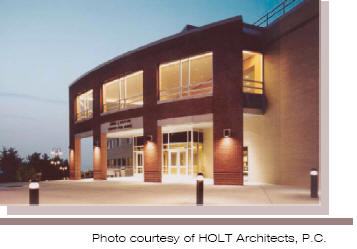 |
 |
|
|
THESIS ABSTRACT Many factors contributed to my selection of the James J. Whalen Center for Music at Ithaca College as my senior thesis building. I first became aware of the project through a professional contact at HOLT architects, who designed the building, and it made it to my short list of buildings I was considering. Ithaca is relatively close to my hometown of Elmira, NY, and that made it quite easy to visit the building. The building has a very unique feel, and fills a unique position on campus, dealing with very hilly south side of campus, and integrating with the existing Ford Hall and the adjacent Gannett Library. My personal experience with music as a member of bands and choirs in high school, and currently the president of the Penn State Glee Club, the musical aspect of the facility appealed to me as well. The versatility of the building is impressive, and the fact that the lighting systems within the building would have to support a variety of tasks instantly stood out as a challange. The most unique feature of the facility is the four story atrium attaching the new construction to the west of the old Ford Hall to the existing structure. Sloping walkways, crossing structural members, bright angular daylight, and exposed HVAC ductwork give a unique feel to the space. The interface with the existing building reminds people of what this new facility grew from and celebrates the new and expansive addition the the home of the school of music. Click here to see the abstract poster which shows general information on the facility and its systems.
Please Note: While great efforts have been taken to provide accurate and complete information on the pages of this CPEP, please be aware that the information contained herewith is considered a work-in-progress for this thesis project. Modifications and changes related to the original building designs and construction methodologies for this senior thesis project are solely the interpretation of Benjamin Hagan. Changes and discrepancies in no way imply that the original design contained errors or was flawed. Differing assumptions, code references, requirements, and methodologies have been incorporated into this thesis project; therefore, investigation results may vary from the original design. This page was last updated
11/17/2003 |
|